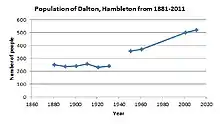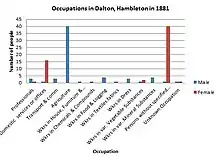| Dalton | |
|---|---|
.svg.png.webp) Dalton Location within North Yorkshire | |
| Population | 518 (2011 census)[1] |
| OS grid reference | SE434763 |
| Civil parish |
|
| Unitary authority | |
| Ceremonial county | |
| Region | |
| Country | England |
| Sovereign state | United Kingdom |
| Post town | THIRSK |
| Postcode district | YO7 |
| Dialling code | 01845 |
| Police | North Yorkshire |
| Fire | North Yorkshire |
| Ambulance | Yorkshire |
Dalton is a village and civil parish in the Hambleton District of North Yorkshire, England. It is about 4 miles (6.4 km) south of Thirsk and near the A168 road. It mainly consists of farmland as well as an industrial estate. It has a population of 518.[1]
.jpg.webp)

History
The toponym is first recorded as Deltone in the Domesday Book of 1086. The name is derived from the Old English dæl "valley" and tūn "settlement", so means "valley settlement".[2]
Dalton had 10.2 households in 1066 which is quite a small amount in comparison to other parishes according to the Domesday book. The total tax assessed is 5.2 geld units, which is quite large for a parish. The Lord in 1066 was called Bernwulf and the value to the lord was £4. The Lord as well as tenant-in-chief in 1086 was William of Percy and the value was £5. Dalton had 15 ploughlands, one mill, one church and four furlongs worth of woodland.[3]
In 1086 Dalton was a berewick (outlying estate) of Topcliffe, and by the 15th century was known as a manor. Until the 19th century it remained a township of the large ancient parish of Topcliffe in the wapentake of Birdforth in the North Riding of Yorkshire. In 1866 it became a separate civil parish.[4]
In 1870, John Marius Wilson recorded:[5]
Dalton, a township in Topcliffe parish, N. R. Yorkshire; on the Great North of England railway, 4¼ miles S of Thirsk. Acres, 1, 247. Real property, £1, 709. Pop., 307. Houses, 77. There are chapels for Wesleyans and Primitive Methodists.
In 1890 Dalton was made up of 2,649 acres of land and 177 acres were covered in plantations. Some of it was elevated moorland and the rest was fertile land. A small ‘chapel of ease’ was created here in 1839 in which a service used to be held every second Sunday morning of the month, and every evening on all the other Sundays. In 1855 the Wesleyan Methodist Chapel was created which was described as “a very small and plain building”.
During the Second World War, RAF Dalton was used as an airfield by RAF Bomber Command. It was home to No.102 Squadron in November 1941. In 1943 it was allocated to No.6 Group Royal Canadian Air Force (RCAF).[6]
In 1974 Dalton became part of the new county of North Yorkshire.
Geography
The distance from London to Dalton is 191 miles (307 km).[7] The closest railway station is Thirsk station at a distance of 5 miles (8 km).[8]
Demographics


Occupation history
In 1881 the dominant occupation was in agriculture with 40 males in that profession. In 2011 this had changed to 32 males becoming Managers, Directors and Senior Officials in Dalton.[9] In 1881 the main profession for females was domestic services or offices, by 2011 this had changed to 16 women being Managers and Senior professionals.[10]
Housing
The average price of a property in North Yorkshire is £193,666. In the postcode region YO7 the average for all properties is £224,608.[11] In 1881 there were 67 houses, by 1951 this had increased to 104 and then 10 years later, in 1961 decreased to 83.[12] Between 1881 and 1901 there were six houses vacant and none being reconstructed, this means that many houses must have been built by 1951.[13]
Education
Currently, there are ten schools with a three-mile radius of Dalton, such as Topcliffe-pre school playgroup which is 1.7 miles (2.7 km) away. According to the 2009 Ofsted report, the ‘Overall effectiveness’ was given a score of 2.[14] Primary schools include Cundall Manor Preparatory School, Sessay Church of England Voluntary Controlled Primary School and Queen Mary’s School.[15]
References
- 1 2 UK Census (2011). "Local Area Report – Dalton Parish (1170216827)". Nomis. Office for National Statistics. Retrieved 19 April 2018.
- ↑ Watts, Victor, ed. (2010). "Dalton (5)". The Cambridge Dictionary of English Place-Names. Cambridge University Press. ISBN 9780521168557.
- ↑ Powell-Smith, Anna. "Place: Dalton". Domesday Book. Phillimore & Co. Retrieved 22 April 2013.
- ↑ Page, William, ed. (1923). "Parishes: Topcliffe". Victoria County History. A History of the County of York North Riding: Volume 2. pp. 70–80. Retrieved 25 July 2018.
- ↑ Wilson, John (1870–72). Gazetteer of the British Isles (1st ed.). Edinburgh: Bartholomew. Retrieved 4 February 2013.
- ↑ Delve, Ken (2006). Northern England : Co. Durham, Cumbria, Isle of Man, Lancashire, Merseyside, Manchester, Northumberland, Tyne & Wear, Yorkshire. Ramsbury: Crowood. pp. 96–98. ISBN 1-86126-809-2.
- ↑ "Where is Dalton? Dalton on a map". www.getthedata.com. Retrieved 6 May 2021.
- ↑ "99" (Map). Northallerton & Ripon. 1:25,000. Landranger. Ordnance Survey. 2017. ISBN 978-0-319-26197-2.
- ↑ "Dalton CP/Tn". A Vision of Britain through time. Retrieved 1 May 2013.
- ↑ "Occupation Males – 2011". Neighbourhood Statistics. Retrieved 1 May 2013.
- ↑ "Property values in North Yorkshire". Zoopla. Retrieved 1 May 2013.
- ↑ "Historical Statistics – Housing". A Vision of Britain through time. Retrieved 1 May 2013.
- ↑ "Historical Statistics". A Vision of Britain through time. Retrieved 1 May 2013.
- ↑ "Topcliffe Pre-School Playgroup". Ofsted. Retrieved 1 May 2013.
- ↑ "Spectrum Spatial Analyst". maps.northyorks.gov.uk. Retrieved 6 May 2021.
External links
![]() Media related to Dalton, Hambleton at Wikimedia Commons
Media related to Dalton, Hambleton at Wikimedia Commons